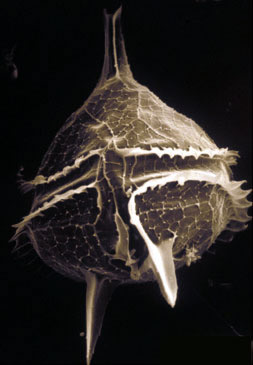Dinophyta (Pyrrophyta): Dinoflagellates
See also: Red Tides
Characteristics. Chlorophyll a & c, beta-carotene and a range of xanthophyll pigments including fucoxanthin and the characteristic peridinin, neoperidinin, dinoxanthin, neodinoxanthin, and diatoxanthin. Histones are absent. Food reserves are starch (similar in structure to that of flowering plants) and oil.
 The wall or theca, when present, is composed of cellulose. Pyrenoids and eyespots may be present. Projectiles known as trichocysts and cnidocysts are found in a number of species and probably have a protective or evasive function. The dinoflagellate nucleus is very distinctive in that it has an unusual combination of prokaryotic and eukaryotic characteristics. It is described as a mesokaryon and has permanently condensed chromosomes. Some species of dinoflagellates have non-condensed chromosomes at some stage in their life cycle. Chromosomes are generally membrane attached and the nuclear membrane remains intact during mitosis. The Dinophyta are probably a very ancient group that diverged from other eukaryotic organisms before the evolution of typical eukaryotic chromatin but after the evolution of repeated DNA sequences.
The wall or theca, when present, is composed of cellulose. Pyrenoids and eyespots may be present. Projectiles known as trichocysts and cnidocysts are found in a number of species and probably have a protective or evasive function. The dinoflagellate nucleus is very distinctive in that it has an unusual combination of prokaryotic and eukaryotic characteristics. It is described as a mesokaryon and has permanently condensed chromosomes. Some species of dinoflagellates have non-condensed chromosomes at some stage in their life cycle. Chromosomes are generally membrane attached and the nuclear membrane remains intact during mitosis. The Dinophyta are probably a very ancient group that diverged from other eukaryotic organisms before the evolution of typical eukaryotic chromatin but after the evolution of repeated DNA sequences.
Dinoflagellates are typically unicellular, free-swimming, biflagellate organisms that constitute an important component of freshwater, brackish and marine phytoplanktonic communities. There are, however, a number of non-motile forms including amoeboid, coccoid, palmelloid and filamentous types. Most have some form of photosynthesis, but some are saprophytic (feeding on decayed organic matter), symbiotic, or holozoic (feeding like an animal by ingesting solid food particles). Some are highly modified parasites.
The flagella of the motile cells are very distinctive. The typical pattern is a pair of unequal, heterodynamic flagella, which have independent beating patterns.
In dinoflagellates belonging to the Class Dinophyceae, the flagella are located in grooves or depressions. An acronematic (lacking hairs), posteriorly-directed flagellum is located in a longitudinally orientated groove called the sulcus, and a flattened or ribbon-like flagellum is located in a transverse groove, the cingulum, which encircles the cell in the equatorial region or closer to one pole than the other. The transverse flagellum coils around the cell, and its beat causes the cell both to turn and to be propelled in an anterior direction. Fine hairs are reported to be attached to the transverse flagellum.
The other, smaller, class recognized in the Dinophyta, the Desmophyceae, includes dinoflagellates that have both flagella originating from the anterior end, and are bilaterally symmetrical. Asexual reproduction takes place by fission. Sexual reproduction has been only rarely reported; vegetative cells divide by meiosis in Noctiluca miliaris to form up to 2000 uniflagellate isogametes. Pairs of gametes fuse and the zygote, after a resting period, develops directly into a vegetative cell. This species is unusual in having what appears to be a typical eukaryotic nucleus in the vegetative cells, but a typically dinophycean nucleus in the gametes.
The Dinoflagellates include about 150 genera and 3000 species.





